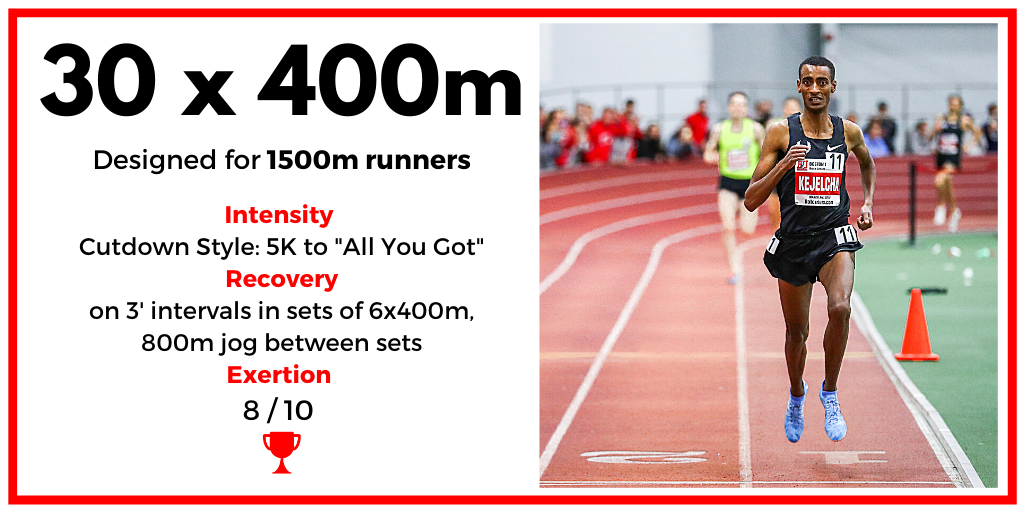Workout of the Day: 30 x 400m
30 x 400m performed in 5 sets of 6 x 400m
Intensity — Cutdown Style: Set 1 @ 5K, Set 2 @ 3K, Set 3 @ 3K, Set 4 @ 2K, Set 5 @ 1M
Recovery — on 3’ intervals within a set, 800m easy jog between sets
Exertion — 8/10
Context & Details
People like big numbers. 30 x 400m totals to 12,000m — and that’s a big number. However, with workouts, runners and coaches must ask themselves if big numbers are necessary for the runner in consideration.
In the case of this workout, yes the big number of 400m repeats was necessary, as this was a workout Jim Ryun performed in-season later in his career. So for him it made sense. For runners you coach perhaps 1, 2 or 3 sets of 6 x 400m makes better sense. What matters most with workouts is if the desired stimulus is achieved. And the desired stimulus is always athlete specific.
There is no such thing as a generic training plan. All training plans must be individually specific to be effective. Nowadays there are a lot of generic training plans for every distance for sale. And none of them work. Save your money. Or better yet, hire a coach who is knowledgeable, experienced, and intelligent enough to craft a customized plan tailored to you.
Coaches who work with large high school, college, or club teams are tasked with working a little more to design effective training plans for each runner they coach. Overlap of workouts and training sessions may occur, but each runner’s plan needs to be customized to that person to be effective. It’s hard but worth it.
OK — let’s get to why this workout design works in general, and why it worked for Jim Ryun and Alan Webb (who did 20 x 400m, in 5 sets of 4 in 2017).
As a runner gets better, the amount of quality work they need to perform to achieve a useful stimulus increases as well. You can increase quality work via intensity (speed or power), by volume, or by a combination of both speed & volume increases.
Ryun and Webb were both world-class milers. They both ran very fast 1 Mile times in high school. For them, as adults, they both reached near-maximal ability in their raw speed early. When you run 3:47 or 3:51 on cinders for 1 Mile, it becomes really hard to get faster. Therefore, for them doing a high volume of 400s, at specific speeds, on disciplined recovery intervals was one of the best ways left to them to generate a novel stimulus.
Intensity, density, and volume are the 3 variables we can manipulate to achieve the desired stimulus (or stimuli) in workouts.
And as mentioned before, high-end intensity (or speed) was maxed out for them. So by clustering or chunking, the 400s into sets (Webb sets of 4, Ryun sets of 6), they were able to also prolong the duration of their exposure to desired specific speeds. Their aim was to extend their ability to run with little or no fatigue at mid-to-low 60”/400m speed. They could do more 400s at a higher quality of intensity this way than doing consecutive 400s on the same recovery intervals. Therefore, this method of structuring repeat 400s allowed them to achieve a higher overall stimulus, and after a period of recovery, a higher adaptation.
This method of chucking 400s at 5K speeds and cutting down is something any coach or runner can include in their training program. It upgrades VO2 Max, vVO2 Max, lactate-threshold velocity, resistance to fatigue, aerobic power, and running economy quite well.
In general, start out with a 1:2 work-to-rest ratio between the 400s and recovery intervals in a set, and 1:4-5 work-to-rest ratio between sets. To advance the session after the runner has established the desired paces on the 400s, simply increase the density of a set by adding 1-2 400s or shortening the recovery intervals by 15”-30” seconds. Ideally, you want to do this session once a week or alternating weeks for 6 - 10 weeks to see a stable adaptation that will transfer to race day in late season for the miler.

